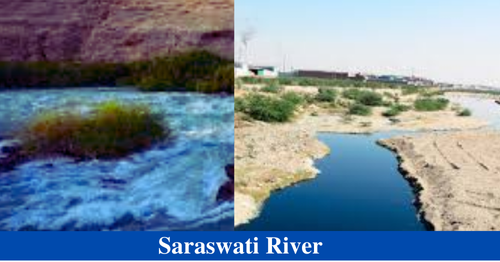Saraswati River Unveiling the Secrets of the Ancient River
Saraswati River
The River has long been a source of mystery, despite being adored in Hindu mythology and frequently mentioned in ancient Indian writings. For years, researchers, scientists, and historians have been fascinated by the loss of the Saraswati, a once-powerful river that was crucial in the development of early Indian civilizations.
This blog explores the mythological significance of the Saraswati River, its origins, secrets, and historical significance, as well as scientific efforts to map its ancient flow.

Saraswati River Origin
The Saraswati River was said to have its source in the Himalayas, close to the Yamunotri Glacier in Uttarakhand, as per historical records. It was thought to flow southwest and empty into the Arabian Sea after passing through the modern Indian states of Gujarat, Rajasthan, Punjab, and Haryana. The river was a lifeline for the civilizations that flourished along its banks since its path spanned a wide and fertile area.
The Saraswati River's Secrets
The abrupt disappearance of the Saraswati River is one of its most fascinating features. According to geological and archeological research, the river may have been rerouted by tectonic action, which is why it started to dry up about 1900 BCE. Another argument suggests that the region’s decreased rainfall as a result of climate change decreased the river’s flow. It is thought that the Saraswati River’s drying up had a major effect on the Harappan civilization and contributed to its downfall.
Also Read The Article About Vedas.
Where It End Mythology and Reality
The Saraswati River is described in Hindu mythology as a celestial embodiment of purity, knowledge, and wisdom in addition to being a physical entity. It is believed to be the embodiment of Saraswati, the goddess of education and the arts. According to mythology, the river joins the Ganges and Yamuna at the Triveni Sangam in Allahabad (Prayagraj), a Hindu holy confluence.
Geographically speaking, it is thought that the Saraswati’s vestiges finish in the Thar Desert, with some of their traces merging into the Rann of Kutch. Geological investigations and satellite photography have been useful in tracing the dry riverbeds and revealing information about their former route.
Map and Route of the Saraswati River
Charting the historical path of the Saraswati River has proven to be a difficult but fascinating undertaking. Scientists have been able to reconstruct the river’s path by combining geological investigations, satellite photos, and remote sensing technologies.
Origin: The Yamunotri Glacier in the Himalayas is thought to be the river’s original source.
Flow through Punjab and Haryana: It passed through the areas that are now known as Punjab and Haryana, offering an ideal environment for habitation.
Passing through Rajasthan: The river then traversed the Thar Desert in Rajasthan, where its remnants are most evident today.
Ending in Gujarat: Finally, it is believed to have flowed into the Arabian Sea through the Rann of Kutch in Gujarat.







Pingback: Hidden Hindu Where To Read Online Versions Read Out Now
Pingback: Legend Agroha Dham The Spiritual Heart of Haryana